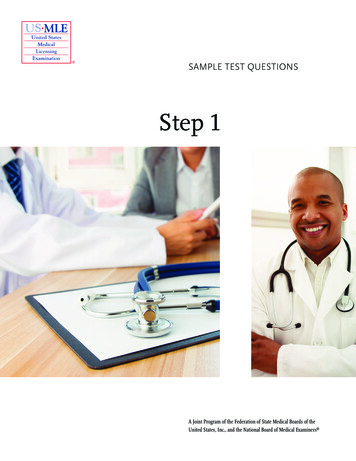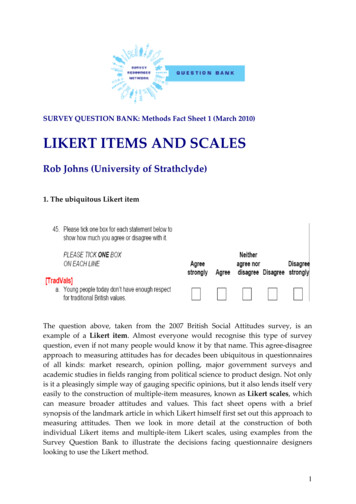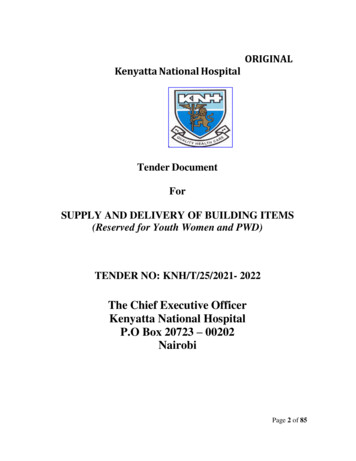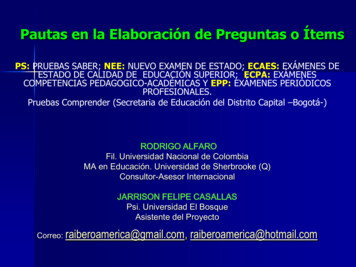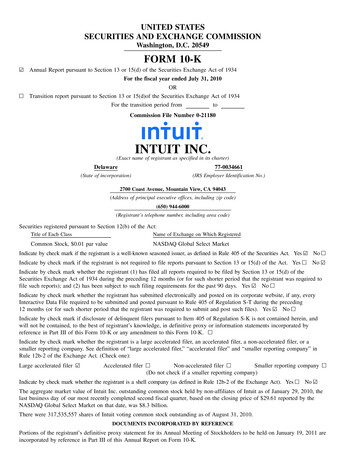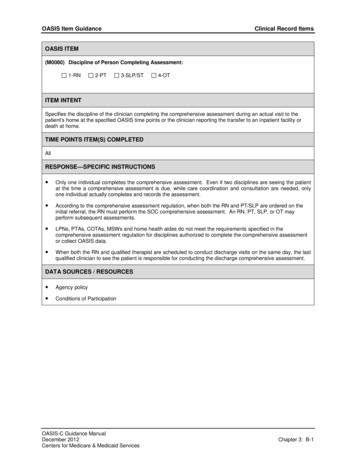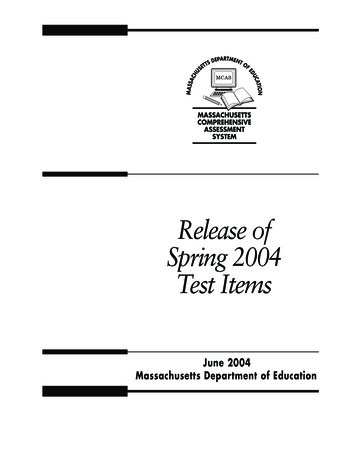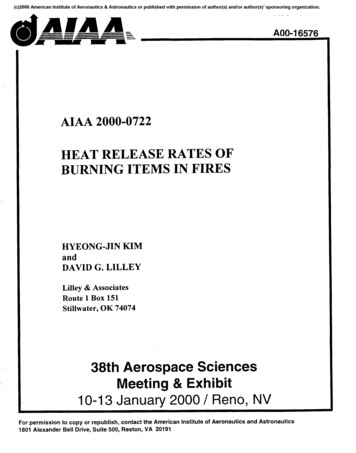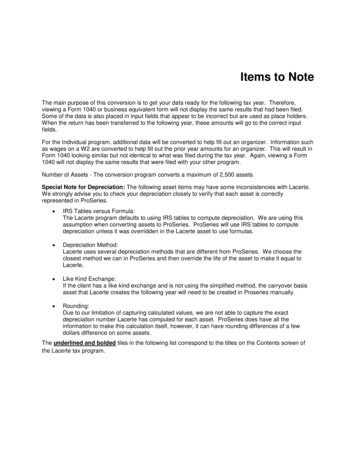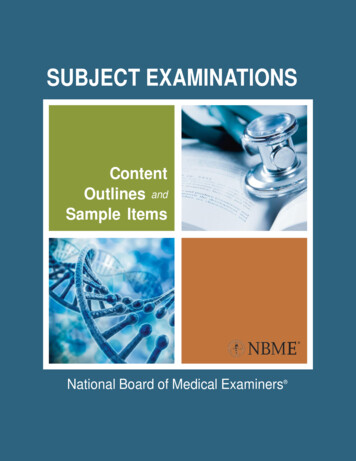
Transcription
SUBJECT EXAMINATIONSContentOutlines andSample ItemsNational Board of Medical Examiners
TABLE OF CONTENTSBASIC SCIENCESBehavioral SciencesBiochemistryGross Anatomy and gyPharmacologyPhysiology11017243139475562CLINICAL SCIENCESAmbulatory CareClinical NeurologyFamily Medicine ModularMedicineObstetrics and 1120129HEALTH SYSTEMS SCIENCE138ADVANCED CLINICALSEmergency Medicine Advanced ClinicalInternal Medicine Advanced Clinical143148COMPREHENSIVE EXAMINATIONSComprehensive Basic ScienceComprehensive Clinical Science153161INTRODUCTION TO CLINICAL DIAGNOSIS169Copyright 2003, 2008-2019 by the National Board of Medical Examiners (NBME ). Some contentused with permission from third parties.
Behavioral ScienceSystemsGeneral Principles of Foundational ScienceBehavioral HealthNormal processesAdaptive and maladaptive behavioral responses to stress and illnessPatient adherencePsychotic disordersAnxiety disordersMood disordersSomatic symptoms and related disordersFactitious disordersEating disorders and impulse control disordersDisorders originating in infancy/childhoodPersonality disordersPsychosocial disorders/behaviorsSubstance use disordersAdverse effects of drugsNervous System & Special SensesNormal processesInfectious, immunologic, and inflammatory disordersDegenerative disorders/amnestic syndromesGlobal cerebral dysfunctionMovement disordersParoxysmal disordersSleep disordersTraumatic and mechanical disorders and disorders of increased intracranial pressureCongenital disordersAdverse effects of drugs on the nervous systemMultisystem Processes & DisordersNutritionAbuseBiostatistics, Epidemiology/Population Health, & Interpretation of the Medical Lit.Social Sciences, Including Communication and Medical Ethics & �5%25%–30%
1.A 50-year-old man develops difficulty walking while receiving drug therapy for paranoid behavior. Physicalexamination shows masked facies and diffuse muscle rigidity. He is slow in initiating movement and walks with ashuffling narrow-based gait. Which of the following drugs is the most likely cause of these findings?(A)(B)(C)(D)(E)2.A 24-year-old man is brought to the emergency department by his mother after barricading himself in hisapartment. For 8 months, he has believed that aliens follow him and control his mind. He was fired from his parttime job 6 months ago because of unusual behavior. There are no other apparent psychosocial stressors. His paternalgrandmother has major depressive disorder. He does not use drugs, but his mother states that he frequently drinksbeer. There is no disturbance of mood, sleep, or appetite. Examination shows an extremely agitated and suspiciouspatient. There is a 1 1-cm abrasion in the right frontal area. His blood alcohol concentration is 0.5 mg/dL, andserum γ- glutamyltransferase (GGT) activity is 40 U/L (N 5–50). Which of the following is the most likely diagnosis?(A)(B)(C)(D)(E)3.Alcohol-induced mood disorderBipolar disorder, manicBrief psychotic disorderSchizoaffective disorderSchizophrenia, paranoid typeA 43-year-old woman is brought to the emergency department 1 hour after a stranger stole her purse. She isagitated and extremely upset. She is 163 cm (5 ft 4 in) tall and weighs 91 kg (200 lb); BMI is 34 kg/m2. Physicalexamination shows no other abnormalities. Her blood glucose concentration is increased. Which of the following is themost likely explanation for this Monoamine oxidase inhibitorPhenothiazineTricyclic compoundβ-Cell hypersecretionCushing diseaseGlucagon-secreting adenomaPancreatitisNormal stress hormone responseA 4-year-old girl is brought to the physician by her mother because of a fever for 1 day. The physician is more than1 hour behind schedule because of two patient emergencies earlier that day. When he enters the room, the mother yells,“Do you know how long we've had to wait? This is totally unacceptable!” It is most appropriate for the physician toinitially state which of the following?(A)(B)(C)(D)(E)“I am frustrated, too, with being so far behind schedule.”“I hope my staff explained about the difficult patients who caused the delay.”“It must have been very difficult to be here for so long with a sick child.”“My office staff scheduled too many patients for today.”“Unfortunately, some patients demand more time than we scheduled for them.”2
5.A 45-year-old man is admitted to the hospital because of chest pain for 1 hour. He has a sedentary lifestyle, andhis diet is high in fat and sodium. The diagnosis of acute angina is made, and the appropriate treatment isadministered. After the patient’s condition is stabilized, the physician recommends an exercise regimen and alow-fat, low-sodium diet. Two weeks later, the patient returns for a follow-up examination. He indicates thathe has not yet returned to work and spends most of the day lying on the couch. He has not had any chest pain,shortness of breath, dyspnea with exertion, or peripheral edema. Which of the following initial statements bythe physician is most appropriate?(A)(B)(C)(D)(E)6.A firstborn 1-year-old girl is hospitalized for evaluation of arrested growth. Pregnancy and delivery wereuncomplicated, and development was normal initially. The infant is listless and has a diaper rash. She is below the 5thpercentile for length and weight. No other abnormalities are noted. After 1 week of routine hospital care, the infant hasgained 1 kg (2.2 lb) and has become more responsive. Which of the following is the most likely explanation for thearrested growth?(A)(B)(C)(D)(E)7.HypothyroidismInfantile psoriasisMilk allergyParental neglectPyloric stenosisA 15-year-old boy with generalized tonic-clonic seizures is brought to the physician by his mother for a follow-upexamination. She says he has not been taking his medication regularly. In his presence, she explains to the physicianthat she is baffled by her son’s behavior and “can’t get him to take his pills, let alone take out the trash.” Even after hismother leaves, the patient stares out the window and refuses to talk. Which of the following behaviors during theinterview is most appropriate to assess the patient’s compliance with this regimen?(A)(B)(C)(D)(E)8.“Are you afraid you might have a heart attack if you exercise?”“Are you doing any types of exercise other than channel surfing?”“Have you also not been following the diet I recommended?”“What do you think is interfering with your ability to resume activity?”“When would you like to start working on improving your health?”Confront the patient about his poor behaviorExplain the patient’s resistance to himLaugh and joke with the patientProject a firm, businesslike mannerProject a respectful, tolerant attitude and encourage free discussionThe children of a 67-year-old woman ask their family physician for advice about their mother’s behavior 4 weeks afterthe death of her husband of 40 years. They are concerned because she weeps whenever she comes upon an object in herhome that she associates with him. Her appetite has decreased, and she has had a 2-kg (4.4-lb) weight loss. Sheawakens 1 hour before the alarm goes off each morning. She is able to care for herself. Although she does not leave herhome for any social activities, she does enjoy visits from her family. Which of the following is the most likelyexplanation and appropriate management?(A)(B)(C)(D)(E)Normal grief reaction, and she requires no medical attentionNormal grief reaction, and she would benefit from diazepam therapyPathologic grief reaction, and she should be treated with an antidepressantPathologic grief reaction, and she should be treated with psychotherapyPathologic grief reaction, and she should be encouraged to move in with one of her children3
9.A 4-year-old girl is brought to the physician because she consistently uses her left hand. Her mother, who is alsoleft-handed, tells the physician that she wants her daughter to be right-handed because she resents all the obstacles shefaced as a left-handed child. She makes her daughter practice with a crayon held only in her right hand. Which of thefollowing responses by the physician is most appropriate?(A) “I know you want the best for your daughter, but pressing her to change is unlikely to work and mightcause its own problems.”(B) “I understand your concerns, and since she is only 4, your efforts will likely result in her beingright-handed by age 7 years.”(C) “Times have changed. There is much less discrimination against left-handed people now.”(D) “You may be causing irreversible psychological trauma to your child, which could be worse than beingleft-handed.”(E) “You shouldn’t interfere with nature.”10.A 65-year-old man comes to the physician for a follow-up examination after the results of a bronchoscopy showedsquamous cell carcinoma. When the physician tells the patient the diagnosis, the patient becomes tearful and responds,“No, you’re wrong! This must be a mistake. This can’t happen to me. Let’s do more tests.” This patient is most likely atwhich of the following stages of grief?(A)(B)(C)(D)11.A 10-month-old boy is brought to the emergency department by his babysitter 1 hour after he was difficult to arousefollowing a head injury. The babysitter says he hit his head after falling off a bed and that she could not wake him atfirst when she found him lying on the floor. The patient is conscious and not in distress. Physical examination showsa 2-cm hematoma over the left parietal region of the head. There are ecchymoses in various stages of healing ondifferent body surfaces, including the buttocks and low back. Neurologic examination shows no abnormalities. Whenquestioned about the bruises, the babysitter replies, “He just seems to bruise easily. Maybe he has some sort ofbleeding problem.” After notifying the parents, the physician should do which of the following sionAsk the hospital social worker to obtain a criminal background check on the babysitterHave a court appoint a guardian for the childNotify child protective services of suspected abuseRefer the patient to a pediatric hematologistRegister a formal complaint against the babysitter with the local police departmentA 10-year-old girl is brought to the physician by her parents for a well-child examination. When alone with thephysician, the parents state that they are concerned because some of her friends seem overly preoccupied with foodwhen they are visiting. Their daughter also has begun to show an interest in fashion magazines and stylish clothing.Although their daughter has had consistent and appropriate weight gain throughout her life, the parents are aware of therisks for eating disorders and are eager to do anything they can to avoid such a problem. It is most appropriate for thephysician to recommend which of the following to the parents regarding their daughter?(A)(B)(C)(D)(E)Encourage more family mealsForbid access to fashion magazinesHave her eat more at every mealSuggest she prepare her own mealsWeigh her weekly4
13.A 46-year-old man comes to the physician for a follow-up examination. He underwent coronary artery bypass grafting3 weeks ago. He works long hours daily as the head chef and owner of a restaurant. He has had a 14-kg (30-lb) weightgain since opening his restaurant 3 years ago. He attributes this weight gain to “working around food all day, everyday.” He does not smoke cigarettes. His father had a myocardial infarction at the age of 60 years. The patient is 175 cm(5 ft 9 in) tall and now weighs 102 kg (225 lb); BMI is 33 kg/m2. Physical examination shows no other abnormalities.He tells the physician that he is afraid to cut down on his work hours because his business might suffer as a result, buthe says, “I don’t want to have a heart attack like my dad did.” Which of the following responses by the physician ismost appropriate?(A) “The fact that you do not smoke cigarettes balances out your other risk factors, such as your weightand family history.”(B) “Given your family history, modifying other risk factors won’t have much impact.”(C) “I suggest you have someone else run your business for the time being, so you can spend your days ina more healthy environment.”(D) “Let’s discuss some lifestyle changes, including weight loss, exercise, and decreased stress.”(E) “Since the only risk factor for a myocardial infarction you can change is your weight, I suggest youinitiate a weight-loss program fairly soon.”14.A 40-year-old woman with hypertension comes to the physician for a follow-up examination. Her blood pressureis 160/96 mm Hg. She tells the physician that she has been having difficulty being compliant with hermedication regimen and low-sodium diet. Which of the following responses by the physician is most appropriate?(A) “I will go over the regimen and diet again to make sure you understand them.”(B) “I’d like you to read these pamphlets on the risks of hypertension. You will then realize the seriousnessof your condition.”(C) “If you don’t follow my recommendations, you could end up having a heart attack or stroke. Youcould also become blind.”(D) “Tell me the difficulties you’ve been having. Perhaps we can make your regimen and diet easier foryou to follow.”(E) “Unfortunately, if you do not follow your medication regimen and diet, I will find it difficult to act asyour physician.”15.A 27-year-old woman comes to the physician because of an itchy rash on her hands for 2 weeks. She states that shebegan training as a hairstylist 3 weeks ago and works 6 hours daily, cutting, coloring, and highlighting hair and givingperms. Examination of the hands shows edema with weepy vesicular lesions in a glove pattern bilaterally. Which ofthe following initial actions by the physician is most appropriate?(A) Advise the patient to stop her training and look for another type of
5 13. A 46-year-old man comes to the physician for a follow-up examination. He underwent coronary artery bypass grafting 3 weeks ago. He works long hours daily as the head chef and owner of a
